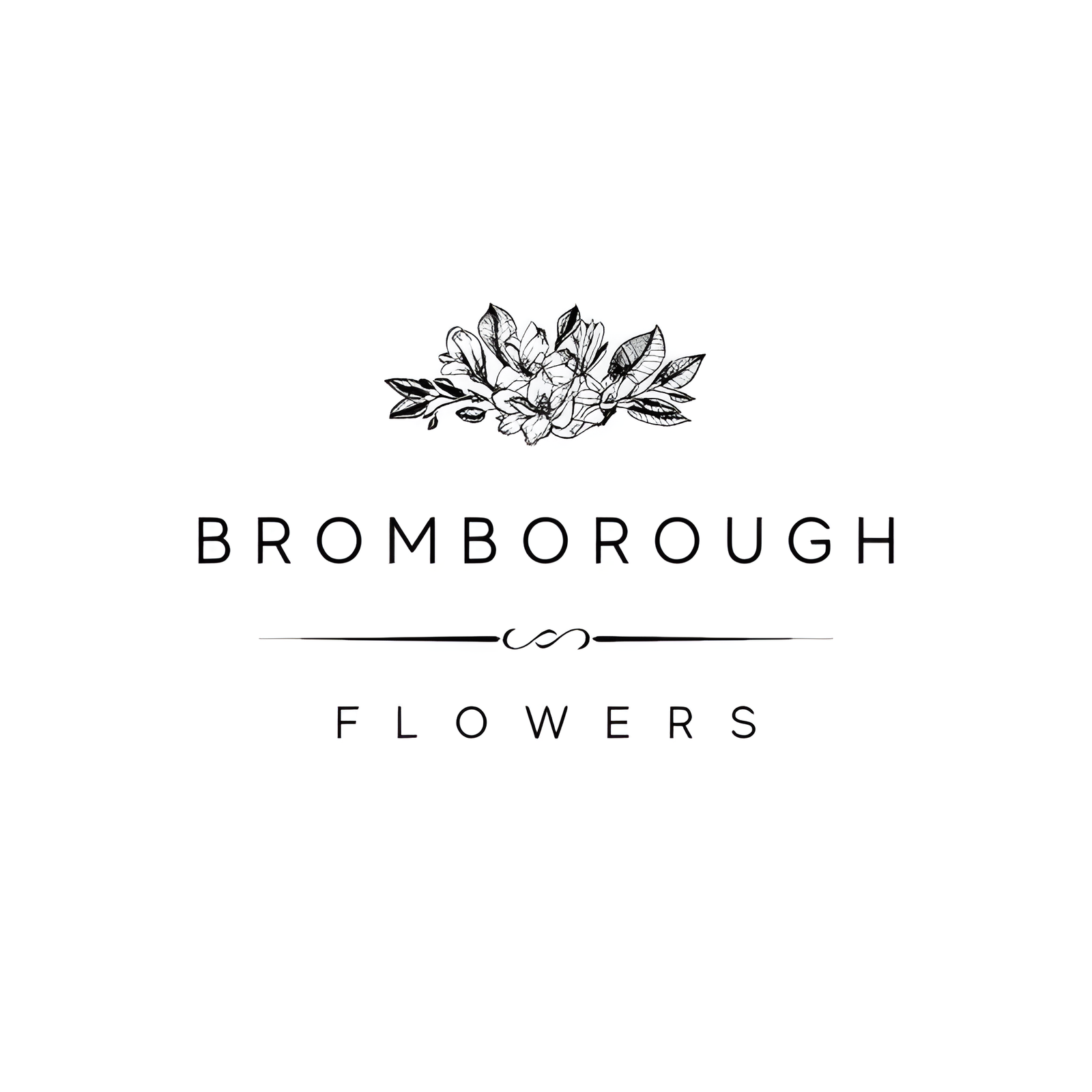In the world of wedding floral arrangements, bougainvillea stands out for its vibrant shades and unique texture, offering an exotic touch that few other flowers can match. With its papery bracts in tones ranging from hot pink to brilliant magenta, this bloom effortlessly grabs attention and adds a hint of tropical sophistication to any wedding setting. But what makes bougainvillea truly remarkable is not just its visual appeal, but also its rich symbolism and versatility in different wedding themes. Join us as we delve into the intriguing characteristics and uses of this enchanting flower in more detail.
Flower Overview
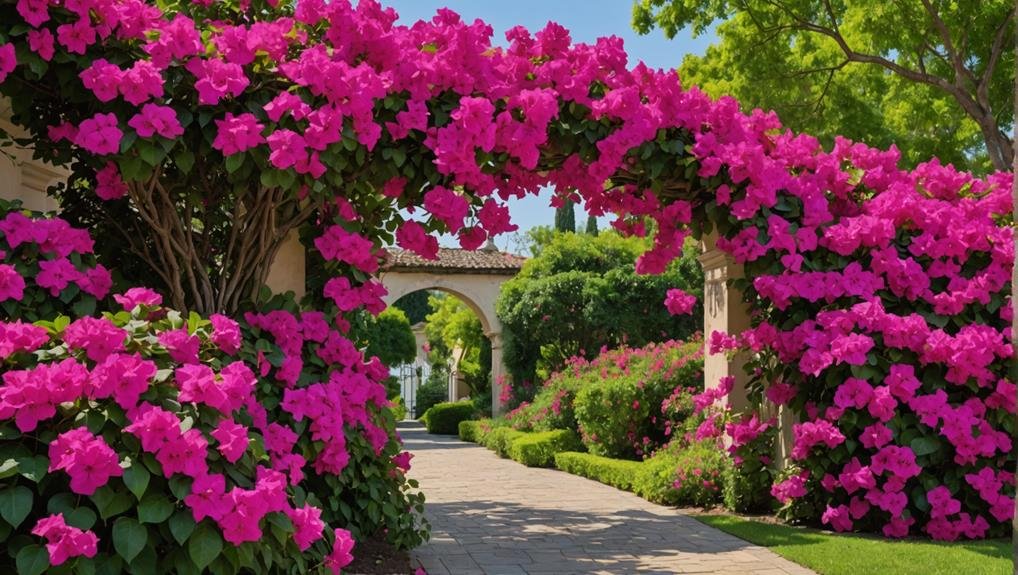
Bougainvillea, with its vibrant and paper-like modified leaves, stands out as a dynamic addition to wedding floral arrangements. Renowned for its bold and bright appearance, bougainvillea can effortlessly enhance the visual appeal of any wedding setting. It pairs harmoniously with popular wedding flowers such as roses, peonies, and ranunculus, creating a striking contrast and adding depth to floral designs.
In the context of a bougainvillea wedding, these vivid blooms serve as a focal point, drawing attention and adding a unique touch to the overall aesthetic. Despite their delicate nature and tendency to fade quickly, bougainvillea’s bright hues can leave a lasting impression. Their modified leaves, often mistaken for petals, surround a tiny white flower at the center, contributing to their distinctive look.
Florists and wedding planners appreciate bougainvillea for its ability to make a statement. Its vibrant colors can be utilized in various elements of wedding décor, from bouquets and centerpieces to archways and backdrops. Incorporating bougainvillea into wedding flowers not only enriches the floral design but also brings an exotic and lively ambiance to the celebration.
Physical Description
Featuring vibrant bracts that resemble delicate paper, bougainvillea presents a visually striking appearance with bright pink modified leaves surrounding a tiny white central flower. This unique structure often leads to the mistaken identification of the bracts as the actual blooms.
The true flowers of bougainvillea are small, tubular, and typically white, nestled within the colorful bracts that steal the spotlight with their vivid hue.
Bougainvillea is not only prized for its visual appeal but also for its durability. When properly cared for, its branches can last several days, making it an ideal choice for wedding decorations. These resilient blooms are especially favored for their ability to maintain their impressive appearance throughout the duration of an event.
In floral arrangements, bougainvillea’s vibrant hue provides an enchanting contrast, complementing other popular wedding flowers such as roses, peonies, and ranunculi.
Despite their delicate appearance, these bracts are robust yet require careful handling to prevent premature fading. This balance of beauty and resilience makes bougainvillea a distinctive and cherished addition to any floral ensemble, contributing both color and texture to wedding décor.
Available Colour Varieties
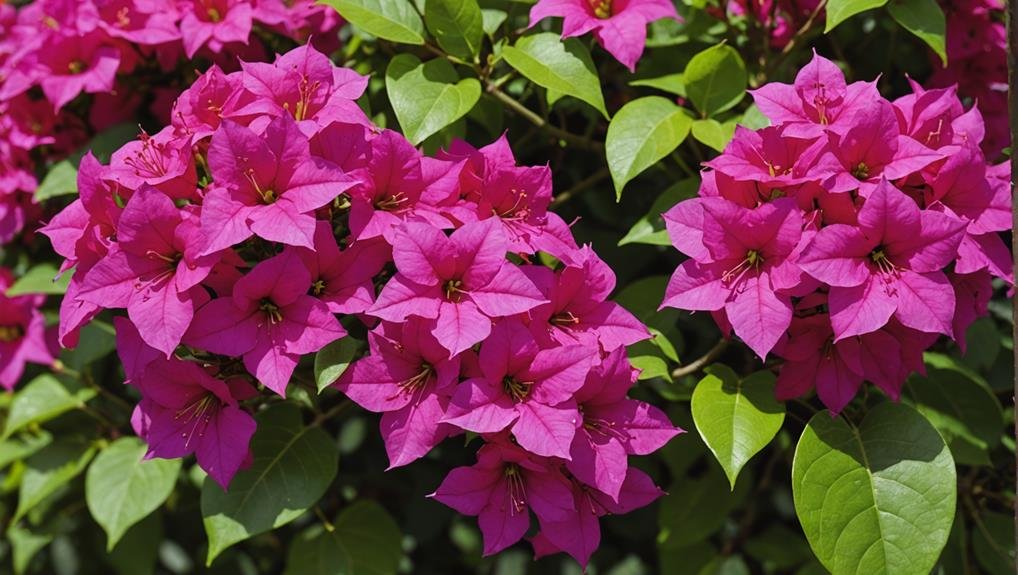
Building on its striking physical characteristics, the vibrant array of color varieties available for bougainvillea makes it a versatile choice for wedding floral arrangements. Bougainvillea blooms are celebrated for their vibrant blooms, ranging from hot pink, magenta, and purple to red, orange, yellow, and white. These color variations are attributed to the bracts—modified leaves that encircle the small, delicate white flowers at the center.
Several popular bougainvillea varieties offer unique hues that can enhance any wedding setting. For instance, the ‘Barbara Karst‘ variety is known for its bright pink to red bracts, making a bold statement. ‘Raspberry Ice‘ adds a touch of elegance with its pink and white combination, while ‘Golden Glow’ introduces a sunny yellow option into the mix.
The intensity of bougainvillea’s color variations can be influenced by environmental factors such as sunlight exposure, soil quality, and climate conditions. This adaptability allows for strategic combination of different color varieties to create stunning floral arrangements that suit the specific aesthetic of any wedding event.
Latin Name and Taxonomy
The Latin name for this striking plant is Bougainvillea spectabilis, and it belongs to the Nyctaginaceae family. This woody, perennial plant is renowned for its vibrant bracts, which are often mistaken for flowers.
The proper flowers of Bougainvillea spectabilis are small and inconspicuous, typically white or yellow, and surrounded by three large, colorful bracts. These bracts are what give Bougainvillea its eye-catching appearance, making it a popular choice for weddings and decorative purposes.
Bougainvillea spectabilis is a member of the Nyctaginaceae family, a group that includes various plants known for their unique flowering structures. The plant was named in honor of Louis Antoine, Comte de Bougainville, a French explorer who is credited with introducing it to the Western world. This genus, which includes around 18 species, is native to South America and thrives in tropical and subtropical climates.
Understanding the Latin name and taxonomy of Bougainvillea provides insight into its classification and botanical characteristics. This knowledge helps in identifying the plant correctly and appreciating its place within the floral world. Its distinct taxonomy underscores its unique features and suitability for various decorative uses, especially in wedding arrangements.
Geographical Origins
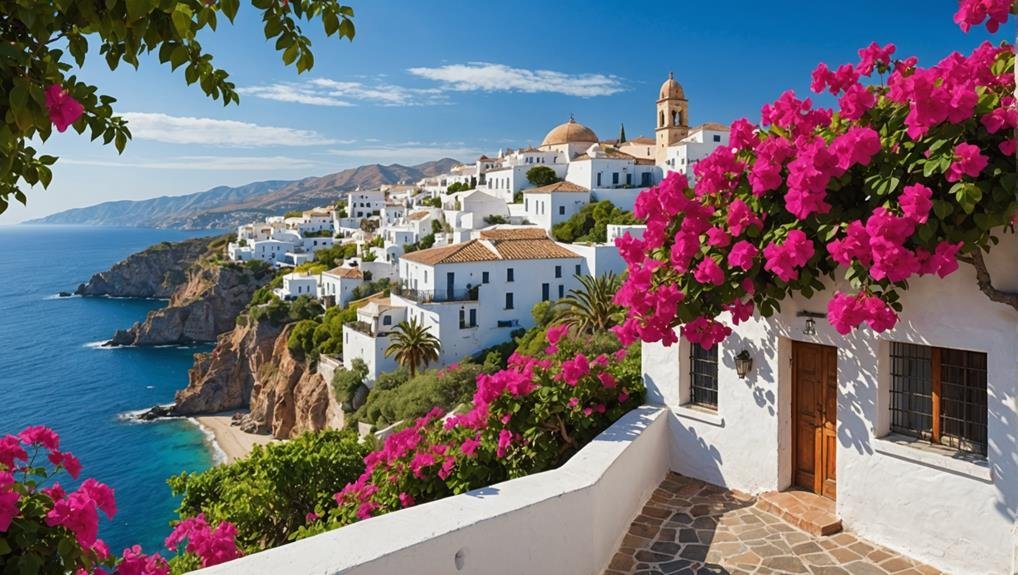
Originating from South America, Bougainvillea is primarily found along the coastal regions of Brazil, Peru, and Argentina. This vibrant plant was first discovered during the round-the-world voyage of the French admiral and explorer Louis Antoine, Comte de Bougainville, after whom it was subsequently named. Its geographical origins in South America have endowed Bougainvillea with the ability to thrive in warm, tropical climates, making it a popular choice for gardens and landscapes in similar environments worldwide.
One of the most striking features of Bougainvillea is its colorful bracts, often mistaken for flowers. These bracts come in a variety of hues, ranging from intense hot pinks and purples to delicate whites and pastels. The vividness of these bracts is a direct result of the plant’s adaptation to its native South American habitats, where vibrant colors are essential for attracting pollinators.
Understanding the geographical origins of Bougainvillea provides valuable insight into its growth habits and environmental preferences. Its South American heritage underscores its resilience and adaptability, characteristics that have contributed to its widespread cultivation and popularity in various regions beyond its native lands.
Season Availability
Bougainvillea’s year-round blooming cycle in tropical climates guarantees its consistent availability for weddings throughout all seasons. This feature makes it an attractive option for couples seeking a reliable and vibrant floral choice. In tropical and warm-weather venues, bougainvillea thrives naturally, providing a stunning natural backdrop for wedding ceremonies and receptions.
However, in northern climates, the availability of fresh bougainvillea may be more restricted due to the plant’s preference for warmer conditions. Couples in these regions may need to source the flowers from specialized florists or consider alternative options.
Eco-conscious couples can particularly benefit from choosing bougainvillea for their weddings, as its widespread abundance in certain areas minimizes the environmental impact of sourcing these flowers. Additionally, the longevity of bougainvillea branches when placed in water—lasting several days—adds to its practicality for wedding decorations.
For those concerned about the potential fading of real flowers, faux silk bougainvillea offers a durable and visually appealing alternative.
These factors make bougainvillea a versatile and enduring choice for weddings across various settings.
Growing Conditions
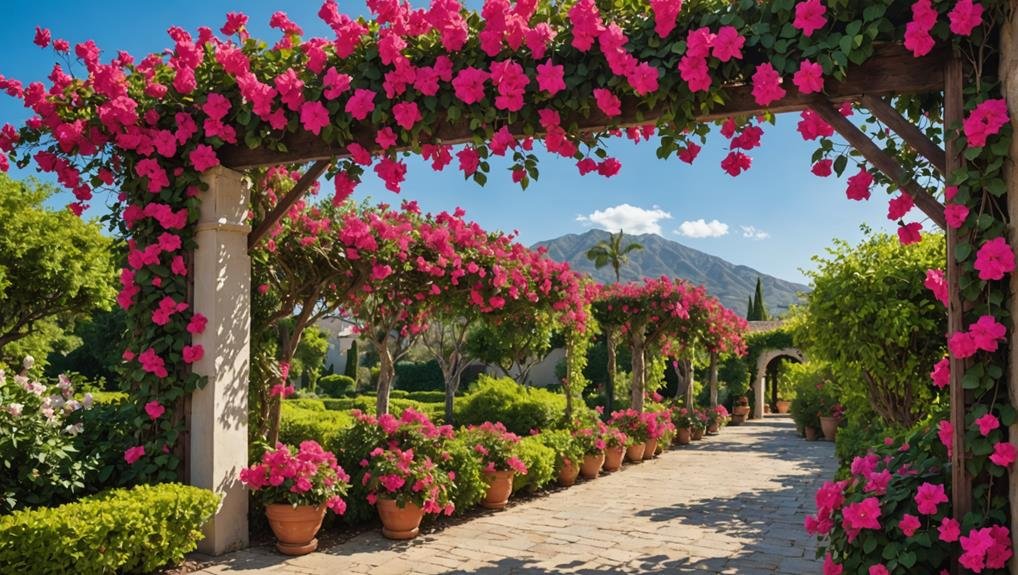
Thriving in equatorial climates such as those found in California, the Caribbean, and Australia, bougainvillea requires specific growing conditions to flourish. This vibrant and tropical plant thrives in hot climates, making it an excellent choice for warm-weather venues.
Bougainvillea prefers well-drained soil with a slightly acidic to neutral pH, and it demands full sunlight to promote its prolific flowering. Adequate water is essential but should be balanced to prevent root rot, which occurs if the soil becomes waterlogged.
For wedding arrangements, bougainvillea branches must be kept in water to maintain their freshness. However, even with proper hydration, the flowers can fade fast, particularly in less hospitable environments. This characteristic underscores the importance of timing in the preparation and display of bougainvillea for events.
While the plant’s vibrant bracts are a draw, their longevity is limited compared to other floral options.
In regions where live bougainvillea is not accessible, faux silk alternatives provide a viable solution, allowing couples to achieve the desired aesthetic without the challenges of sourcing and maintaining fresh blooms.
Therefore, while bougainvillea thrives in ideal climates, careful consideration is necessary to ensure its beauty endures throughout the event.
Cultural Significance
While bougainvillea’s vibrant appearance and specific growing needs make it a popular choice for weddings, its cultural significance in South American traditions further enhances its appeal. In countries such as Brazil, Peru, and Argentina, bougainvillea is more than just a flowering plant; it embodies essential cultural values and deep-rooted symbolism.
The rich, vibrant colors of bougainvillea are often associated with joy, warmth, and hospitality. These qualities make it an ideal choice for wedding ideas that aim to create an inviting and celebratory atmosphere. Additionally, bougainvillea represents resilience, growth, and survival in harsh conditions. This symbolism aligns with the cultural significance of enduring love and commitment, vital elements in any wedding ceremony.
Bougainvillea’s cultural relevance can be summarized as follows:
- Symbolism of Joy and Hospitality: Reflects the welcoming nature of South American traditions.
- Representation of Resilience and Growth: Embodies the spirit of overcoming challenges, resonating with marital vows.
- Vibrant Colors: Adds a touch of cultural richness and vibrancy to wedding celebrations.
- Enduring Love and Commitment: Symbolizes long-lasting love, making it a meaningful addition to wedding décor.
Understanding the cultural significance of bougainvillea enriches its use in weddings, providing both aesthetic and symbolic value.
Typical Use in Weddings
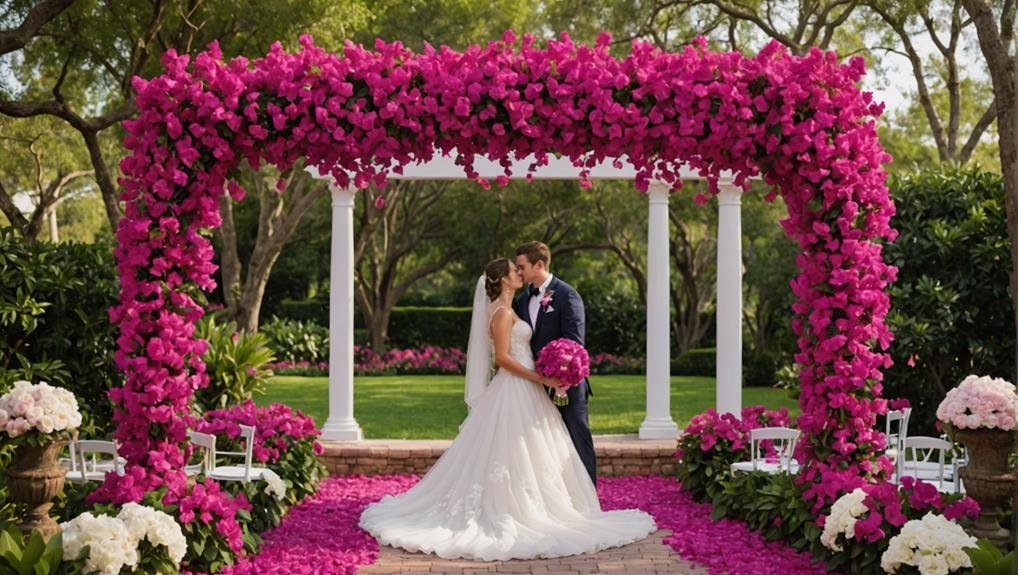
In wedding ceremonies, bougainvillea is frequently employed for creating visually stunning table centerpieces, bouquets, boutonnieres, aisle décor, and elaborate wedding arches. Its vibrant colors and delicate blooms enhance the overall aesthetic, infusing the ceremony space with a tropical atmosphere. This versatile flower symbolizes joy, warmth, and enduring love, making it an ideal choice for adding a touch of romance to weddings.
Bougainvillea’s vivid hues deliver a striking splash of color that not only elevates the decor but also enriches wedding photos, making them memorable and unique. Whether for a traditional church wedding or a more relaxed destination wedding, bougainvillea can be creatively incorporated into various themes and styles. As a standalone decoration, it provides an eye-catching focal point, while when combined with other flowers, it adds depth and beauty to the overall arrangement.
A popular choice for outdoor weddings, bougainvillea is often used to adorn wedding arches, creating a breathtaking backdrop for the ceremony. Its ability to transform any venue into a picturesque setting makes bougainvillea a preferred choice for couples seeking to make their special day unforgettable.
Alternative Flower Types
Complementing bougainvillea with alternative flower types such as roses, peonies, and ranunculi can enhance the overall aesthetic of wedding floral arrangements. These flowers not only offer a varied palette of colors and textures but also contribute to a more balanced and cohesive design. When contemplating alternative flower types, it is essential to select blooms that will seamlessly complement bougainvillea’s vibrant and unique appearance.
Bougainvillea’s striking pink ‘petals’ are actually specialized leaves that envelop a tiny white flower in the center, adding a distinctive charm to wedding decor. To ensure longevity and reduce maintenance concerns, faux silk bougainvillea flowers are an ideal choice, replicating the natural beauty without the risk of fading.
Here are some key points to bear in mind when incorporating alternative flower types:
- Roses: Classic and elegant, roses pair beautifully with bougainvillea, offering a timeless appeal.
- Peonies: These lush and full blooms provide a luxurious touch, enhancing the overall opulence of the arrangement.
- Ranunculi: Known for their intricate layers, ranunculi add depth and texture, making them an excellent complement to bougainvillea.
- Faux Silk Bougainvillea Flowers: Perfect for long-lasting arrangements, these artificial flowers maintain their vibrant hue without wilting.
Combining these elements will create a stunning and memorable floral display for any wedding.
